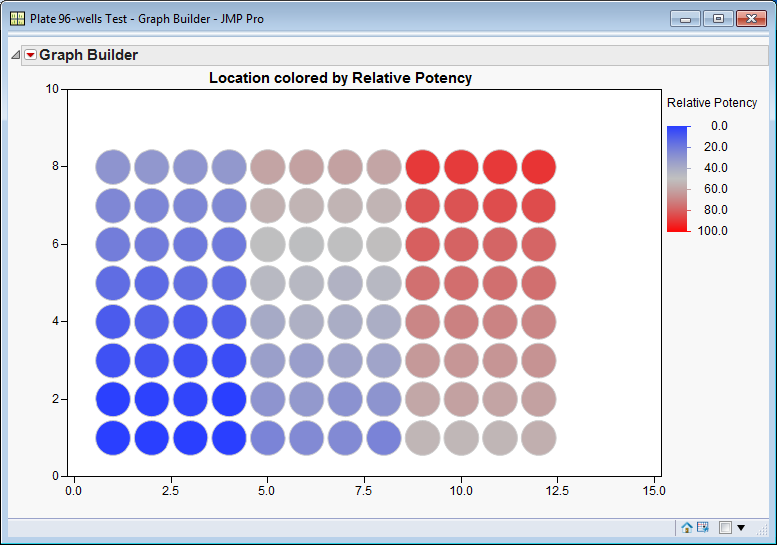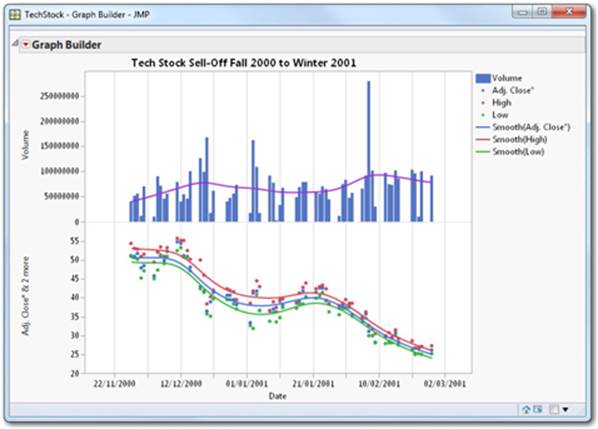

- JMP GRAPH BUILDER POINTS FRONT FULL
- JMP GRAPH BUILDER POINTS FRONT PORTABLE
- JMP GRAPH BUILDER POINTS FRONT CODE
No notes here yet, for now, see Wikipedia. (2) the instruction before the target of a branch. (2) the instruction after a conditional branch Starts with: (1) target of a branch (label) or.To locate basic blocks in flattened code: in the abscence of hardware faults, interrupts, crashes, threading problems, etc.
JMP GRAPH BUILDER POINTS FRONT CODE
maximal-length code block with only one entry and one exit. maximal-length straight-line code block. maximal-length sequence of instructions that will execute in its entirety. Now that we’ve seen the basics of tuples, let’s see how they are stored and manipulated by a compiler.Ī control flow graph is a graph whose nodes are basic blocks and whose edges are transitions between blocks. TODO - bounds checking? allocation? Control Flow Graphs Temporaries differ from variables in that variables come from source language variables that are actually declared, while temporaries are the result of evaluating expressions. Note how tuples assume what is essentially an unlimited supply of registers. X (inclusive) (details left to the implementation) String representation of a boolean (localized?)Īllocate x bytes of memory, returning the address in y (or 0 if the memory could not be allocated).Īllocate x*elsize bytes of memory, where elsize is the number of bytes of an element in array x, returning the address in y (or 0 if the memory could not be allocated).ĭeallocate the memory at address x (or do nothing if x is 0)ĭo something if x is null (details left to the implementation)ĭo something if x is not positive (details left to the implementation)ĭo something if x is not between y (inclusive) and String representation of a float (one can add a new String representation of an integer (one can add a new Increment and jump if equal (useful at end of for-loops that count up to a given value)ĭecrement and jump if not zero (great for loops that count down to zero by one)Ĭall procedure (non-value returning function) f, with arguments x1. Jump if greater or equal / Jump if not less Increment a memory location given its addressĭecrement a memory location given its addressĬopy address of a into z identical to (ADD, a, i*elsize, x) where elsize is the size in bytes of the element type of array a.Ĭopy contents of memory at address a + i*elsize into x where elsize is the size in bytes of the element type of array aĬopy x into the memory at address a + i*elsize where elsize is the size in bytes of the element type of array aĬopy address of s.f into x identical to (ADD, s, ofs(f), x) where ofs(f) is the byte offset of field f in struct s.Ĭopy contents of memory at address s + ofs(f)Ĭopy x into the memory at address s + ofs(f) Here is the tuple representation of the example source code fragment above:ġ if x is greater than or equal to y 0 otherwiseĬopy contents of memory at address x into y Many folks would require a true IR to have some kind of lower level instruction lists. You can even reconstruct the text of the source code from it (up to differences in whitespace and comments). 
Some might not call this an IR, but rather simply a source program representation: it’s what the analyzer produces. The so-called semantic graph is is just an abstract syntax tree, analyzed, type checked, annotated and transformed into a graph: We’ll use a running example code fragment to illustrate various options. Intermediate representations come in many flavors.
To perform machine independent optimizations. (Though this might be a bit of an exaggeration in practice!) JMP GRAPH BUILDER POINTS FRONT FULL
We only have to write $2n$ half-compilers instead of $n(n-1)$ full compilers. We can build a new front-end for an existing back end (so a new machine can quickly get a set of compilers for different source languages). JMP GRAPH BUILDER POINTS FRONT PORTABLE
We can build new back ends for an existing front end (making the source language more portable across machines).To break the difficult problem of translation into two simpler, more manageable pieces.We need a conceptual model of the program, one that we can easily create from the source code, and one that is easy to construct target code from. Because translation appears to inherently require analysis and synthesis.We use intermediate representations for at least four reasons: In a real compiler, you might see several intermediate representations!Ī true intermediate representation is quite independent of the source and target languages, and yet very general, so that it can be used to build a whole family of compilers. MotivationĪn intermediate representation is any representation of a program “between” the source and target languages. If you are building a compiler from a high-level language to assembly language, you’ll almost certainly need to take stop in the middle and create an intermediate representation of the program.






 0 kommentar(er)
0 kommentar(er)
